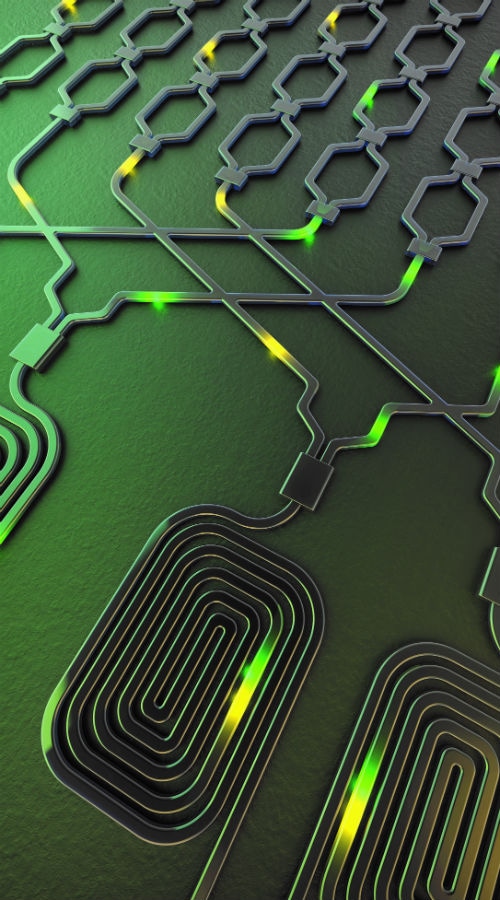Aug 23 2018
An international team of scientists guided by the University of Bristol have shown that light can be employed to implement a multi-functional quantum processor.
 Artist’s illustration of the chip. Tracks called waveguides guide photons in silicon, much like an optical fiber. Spirals of these waveguides are used to generate photons (quantum particles of light) that are then routed around the processor circuit to perform different tasks. (Image credit: Xiaogang Qiang/University of Bristol)
Artist’s illustration of the chip. Tracks called waveguides guide photons in silicon, much like an optical fiber. Spirals of these waveguides are used to generate photons (quantum particles of light) that are then routed around the processor circuit to perform different tasks. (Image credit: Xiaogang Qiang/University of Bristol)
This small device can be used as a scientific tool to conduct a wide range of quantum information experiments, while simultaneously presenting the way in which fully functional quantum computers can be created using large-scale fabrication processes.
They achieved this by engineering a silicon chip that guides single particles of light, referred to as photons in optical tracks called waveguides to encode so-called quantum-bits of information known as “qubits”.
International effort is mounting to create quantum computers as the next step in computing power, to increase the types of tasks that computers can perform for man.
In currently available desktop computers, smartphones, and super-computers, bits take the form of either being a “1” or a “0” and they are the central building block on which all computers presently used in society are founded on.
Quantum computers, on the other hand, are based on “qubits” that can be in a superposition of the 0 and 1 states. Numerous qubits can also be connected in a special way known as quantum entanglement. These two quantum physical properties deliver the power to quantum computers.
One challenge is to build quantum computer processors that can be re-programmed to do a variety of tasks, just like the present-day computers that can be re-programmed to operate various applications.
A second challenge is how to create a quantum computer in a way that its many parts can be manufactured with superior quality and eventually at low cost.
The Bristol researchers have been using silicon photonic chips as a way to attempt to construct quantum computing components on a large scale and today’s result, published in the journal Nature Photonics, shows it is achievable to completely control two qubits of information inside a single integrated chip. This means any task that can be accomplished with two qubits, can be programmed and attained with the device.
Lead author, Dr Xiaogang Qiang, who undertook the work whilst studying for a PhD at the University of Bristol, and currently works in the National University of Defence Technology in China, said: “What we’ve demonstrated is a programmable machine that can do lots of different tasks.
“It’s a very primitive processor, because it only works on two qubits, which means there is still a long way before we can do useful computations with this technology.
“But what is exciting is that it the different properties of silicon photonics that can be used for making a quantum computer have been combined together in one device.
“This is just too complicated to physically implement with light using previous approaches.”
The integrated photonics effort began in 2008 and was a solution to the increasing concern that individual mirrors and optical elements are simply too big and unstable to realize the large complex circuits that a quantum computer needs.
Dr Jonathan Matthews, a member of the research team based at the Quantum Engineering Technology (QET) Labs at the University of Bristol, added: “We need to be looking at how to make quantum computers out of technology that is scalable, which includes technology that we know can be built incredibly precisely on a tremendous scale.
“We think silicon is a promising material to do this, partly because of all the investment that has already gone into developing silicon for the micro-electronics and photonics industries. And the types of devices developed in Bristol, such as the one presented today, are showing just how well quantum devices can be engineered.
“A consequence of the growing sophistication and functionality of these devices is that they are becoming a research tool in their own right—we’ve used this device to implement several different quantum information experiments using nearly 100,000 different re-programmed settings.”